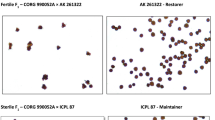Abstract
Fertility restoration of CMS-based hybrids is an integral part of breeding hybrids and the development of new hybrid parents with desirable agronomic and market preferred traits on regular intervals is essential for sustainability of such programs. This paper reports identification of 25 male-sterility maintainers and 179 fertility restorers of A4 cytoplasm in pigeonpea (Cajanus cajan (L.) Millsp.). Multi-location evaluation of hybrids exhibited high stability for fertility restoration across diverse environments. The diversity study showed a large variation for important traits both at phenotypic as well as genetic levels. The potential use of this information in hybrid pigeonpea breeding has been discussed.


Similar content being viewed by others
References
Anderson JA, Churchill GA, Sutrique JE, Tanksley SD, Sorrells ME (1993) Optimizing parental selection for genetic linkage maps. Genome 36:181–186
Dalvi VA, Saxena KB, Madrap IA (2008) Fertility restoration in cytoplasmic-nuclear male-sterile lines derived from three wild relatives of pigeonpea. J Hered 99:671–673
De DN (1974) Pigeonpea. In: Hutchinson JB (ed) Evolutionary studies on world crops. Cambridge University Press, Cambridge, pp 79–87
Haines HH (1920) Plants from Bihar and Orissa. J Asiatic Soc Bengal 1919 15:312
Hanson MR, Bentolila S (2004) Interactions of mitochondrial and nuclear genes that affect male gametophyte development. Plant Cell 16:154–169
Kaul MLH (1988) Male sterility in higher plants. In: Frankel R, Grossman M, Maliga P, Riley R (eds) Monographs of theoretical applied genetics 10. Springer, Heidelberg, pp 775–797
Mallikarjuna N, Saxena KB, Lakshmi J, Varshney RK, Srikanth S, Jadhav D (2012) Differences between Cajanus cajan (L.) Millspaugh and C. cajanifolius (Haines) van der Maesen, the progenitor species of pigeonpea. Genet Resour Crop Evol 59:411–417
Reddy MV, Sharma SB, Nene YL (1990) Pigeonpea: disease management. In: Nene YL, Hall SD, Shiela VK (eds) The pigeonpea. CAB International, New Delhi, pp 303–348
Sawargaonkar SL, Madrap IA, Saxena KB (2012) Study of inheritance of fertility restoration in pigeonpea lines derived from Cajanus cajanifolius. Plant Breed 131:312–314
Saxena KB, Kumar RV (2013) Pigeonpea. Hybrid seed production in field crops. Kalyani Publishers, New Delhi, pp 213–240
Saxena KB, Kumar RV, Srivastava N, Shiying B (2005) A cytoplasmic-genic male-sterility system derived from a cross between Cajanus cajanifolius and Cajanus cajan. Euphytica 145:291–296
Saxena RK, Prathima C, Saxena KB, Hoisington DA, Singh NK, Varshney RK (2010) Novel SSR markers for polymorphism detection in pigeonpea (Cajanus spp.). Plant Breed 129:142–148
Saxena KB, Sultana R, Saxena RK, Kumar RV, Sandhu JS, Rathore A, Varshney RK (2011a) Genetics of fertility restoration in A4 based diverse maturing hybrids in pigeonpea [Cajanus cajan (L.) Millsp.]. Crop Sci 51:574–578
Saxena KB, Vales MI, Kumar RV, Sultana R, Srivastava RK (2011b) Ensuring genetic purity of pigeonpea hybrids by incorporating a naked-eye polymorphic marker in A and B lines. Crop Sci 51:1564–1570
Singh AK, Gopalkrishnan S (2013) Male sterility restoration. Hybrid seed production in field crops. Kalyani Publishers, New Delhi, pp 17–46
van der Maesen LJG (1990) Pigeonpea: origin, history, evolution and taxonomy. In: Nene YL, Hall SD, Sheila VK (eds) The Pigeonpea. CAB International, Wallingford, pp 44–87
Wang Z, Zou Y, Li X, Zhang Q, Chen L, Wu H, Su D, Chen Y, Guo J, Luo D, Long Y, Zhong Y, Liu YG (2006) Cytoplasmic male-sterility of rice with boro ii cytoplasm is caused by a cytotoxic peptide and is restored by two related ppr motif genes via distinct models of m-rna silencing. Plant Cell 18:387–676
Acknowledgments
The authors acknowledge the Genotyping Services Laboratory (GSL) of ICRISAT for providing the genotyping services and also the financial support received from Bill and Melinda Gates Foundation (TL II Project). The authors also acknowledge Dr. Rachit Saxena and Dr. R.K. Varshney of ICRISAT for their support in improving the manuscript and constructive comments. The authors also acknowledge the support of Mr. M. Pentaiaah in the collection of data.
Author information
Authors and Affiliations
Corresponding author
Rights and permissions
About this article
Cite this article
Saxena, K.B., Kumar, R.V. & Bharathi, M. Studies on fertility restoration of A4 cytoplasm in pigeonpea. Euphytica 198, 127–135 (2014). https://doi.org/10.1007/s10681-014-1099-z
Received:
Accepted:
Published:
Issue Date:
DOI: https://doi.org/10.1007/s10681-014-1099-z




